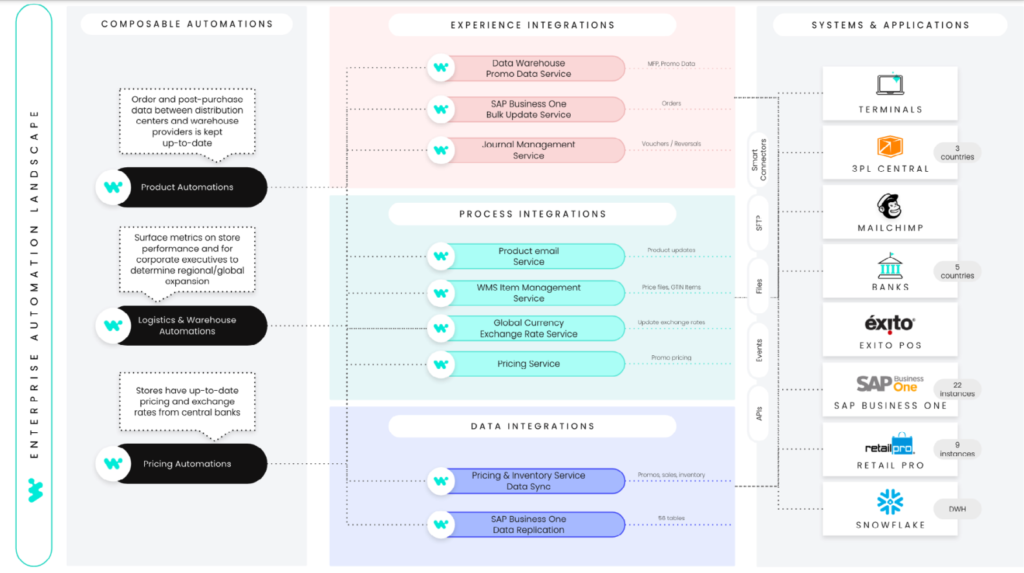Long-lived companies often have a certain set of features in common: adaptability, grit, and guiding principles that outlast fleeting trends. Payless, the international discount footwear chain, has all these elements in spades.
Payless’ resilience would prove to be one of its greatest assets as they faced challenging times. In 2019, Payless closed all of its North American stores and wound down its e-commerce business after filing for Chapter 11. In January 2020, the company emerged from bankruptcy and embarked on a complete digital transformation and simplification of the company’s nearly 500 legacy systems.
They were starting from square one, relaunching with a new brand team and group of trusted partners. As the market was changing drastically due to the COVID-19 pandemic, Payless was rebuilding all while adapting to a massive shift in how businesses were operating. Global shutdowns kept retail stores temporarily shuttered, which meant they needed to launch an e-commerce shop immediately. On top of this, they were overhauling the company’s entire infrastructure, ranging from finance to fulfillment and every other process in-between.
As a result, they would have to reach their goal of a 40% operational cost reduction—not just to bounce back from the challenges of the pandemic, but to continue to deliver on the company’s core value: bringing affordable footwear to the masses.
In 2020, Payless re-entered the North American market with a bang and launched their brand new e-commerce site, providing a totally new commerce experience and reinvigorating the brand.
The challenge
Payless had a few challenges to address: their massive technology stack of nearly 500 legacy systems, costly data center, and reliance on manual processes. To make matters more complicated, they had purged much of their data following the close of their North American stores, losing both institutional knowledge and valuable customer information.
All of these challenges, plus the lack of an e-commerce site, proved unsustainable for Payless as they re-entered the North American market around the start of the pandemic.
There was also an immediate need to drive operational efficiencies through automation. With thousands of orders being processed at any given time, they couldn’t rely on manual processes to keep the supply chain moving at the pace they needed. Customers expect quick delivery times from large e-commerce sites, and automations in the order process were necessary to prevent lagging shipping times and poor customer experiences.
The solution
Payless originally chose Workato to orchestrate email campaigns, though their use cases grew over time. Standing up a solution quickly was crucial—they had many disparate legacy systems to work with, and the newly burgeoning pandemic was keeping consumers out of physical retail spaces, which put them on a time crunch to get an e-commerce platform up and functioning.
Workato’s ease of use, speed to market, and ability to integrate and automate all their legacy systems were crucial not only in launching the website but also in ensuring that it offered the best possible customer experience.
1. Taking a holistic view for streamlined business visibility
Payless had 54 disparate databases that needed to be consolidated. They couldn’t consolidate data in SAP, so they needed a solution that would support good data hygiene for their new data warehouse and business model.
With Workato, they were able to integrate, connect, and simplify their technology stack into one platform, which helped them in multiple ways: less time spent on manual data entry, fewer full time employees (FTEs), and faster speed to market. Plus, the platform was easy to learn, which meant that the IT team could quickly master the Workato platform while leveraging their existing technical expertise and improving their productivity.
Using Workato, they integrated data from several applications into Snowflake, which created a consolidated view of data across all arms of the Payless business. This allowed them to make faster, more confident, and more informed decisions on how to manage inventory and sales. Integrating with Workato also gave them the ability to query across schemas, which ultimately improved reporting. Consolidating and integrating data sources was also a critical step toward reaching their digital transformation milestones and allowed Payless to go live with their new ERP.
2. Digital transformation to improve efficiency and drive innovation
As a globally diversified team supporting 450 stores across Central America, India, and the Middle East, Payless used over 500 systems and tools for the same purpose. They used a combination of in-house, developed tools and an out-of-the-box integration solution from another provider. As their initial stopgap approach became a long-term solution, operational expenses inevitably increased along with technical debt. This made it more difficult for the company to deliver on their mission: to offer footwear to the masses at an affordable price point.
The solution was to consolidate all custom applications into one data warehouse, one POS, one solution for merchandising, one solution for integration, etc. The end goal was to have four to five platforms integrated into one. With Workato, they funneled all the data and system integrations into one platform to enable every department across the business:
- Reporting & Analytics: Moving all SAP BusinessOne data into Snowflake for accurate and timely insights
- Sales: Update SAP BusinessOne with process order information and automatically close sales orders with certain thresholds
- Pricing: Send price files to stores and update exchange rates from central banks to ERP
- Finance: Automate journal vouchers and journal voucher reversals
- Stores: Surface metrics on store performance and for corporate executives to determine regional/global expansion
- Logistics: Synchronizing order and post-purchase data between distribution centers and warehouse providers
- Merchandising: Manage supply and demand as they bring in new inventory for both e-commerce and brick-and-mortar stores
- Warehouse: Send pricing data from Snowflake to warehouse management system (3PL) to distribution center
This digital transformation initiative allowed them to automate critical business processes, creating an entirely new business structure prior to implementing Workato. Even seemingly small process changes had a huge impact on productivity, because they took the more time-consuming, rote tasks off employees’ plates.
For example, they automated a number of arduous tasks that freed up time for existing staff:
• Updating exchange rates from central banks to the ERP
• Sending price files from SAP to distribution centers with shopper traffic data from Snowflake
• Sending promo files to stores
• Adding customer and item info to Mailchimp for marketing emails
• Sending Retail Pro summaries from brick-and-mortar stores for in-country governance via Sigma
Process automations also allowed them to clean up their sales orders and purchase orders for improved data accuracy. For example, if a purchase order is still marked as open and past due by 45 days, but is 97% complete and everything is received, it can be automatically marked as closed.
3. Revamping the commerce experience end-to-end through automation
A seamless order-to-cash process is critical for any business—especially for a retailer that has both an online and brick-and-mortar presence. That’s why one of the top priorities for digital transformation at Payless was to automate journal vouchers for finance.
Before implementing Workato, their process was highly manual. This created major process inefficiencies, heightened the risk for human error, and hindered their ability to provide a good customer experience. Plus, if nothing changed, they’d have to hire 10-30 additional staff just to close the books every month.
Because of the strain this single process put on both the customer experience and the entire finance team, it was business-critical to automate it. Going from a manual journal voucher approval process to automating the uploading and approvals through Workato was a huge boon for the business—it boosted process efficiency and eased the finance team’s heavy workload.
Automating finance processes improved scalability too. Even changes to how they uploaded data to Snowflake showed massive quality-of-life improvements for the finance team. Before automating with Workato, rows in their data uploads had to be by individual SKU. With Workato, they could upload data at the lot level, with individual SKUs cascading from those lots. That means if they had 30,000 rows of SKUs broken into 3,000 lots, they would only need to upload those 3,000 rows for the lots to get all 30,000 individual SKUs logged.
Added up, all these changes made previously slow and arduous processes move much faster. Before Workato, there was no infrastructure to foster process efficiencies, which kept the team working deep in the weeds to make deadlines and keep processes running. Automating these workflows took this manual work off their plates, making processes run faster and more efficiently. Lisa Willis, Application Development Manager at Payless, told us, “I got in service requests where I got the designs approved on Tuesday, and the team had them ready for UAT by Thursday morning.”
The business outcomes
Payless’ digital transformation journey continues to have a profound impact on the business and its customers, extending beyond e-commerce. Before Workato, the team functioned on clunky manual integrations and lacked a cloud infrastructure, leaving them with disconnected, inefficient workflows. Now, almost every business process is in the cloud, and Workato acts as a hub that connects key processes to help them flow efficiently, giving time back to team members who would otherwise be bogged down with manual tasks.
They’ve been able to realize significant results from their digital transformation journey so far:
- Deliver an exceptional commerce experience to their customers and employees by bringing together their data, processes, and experiences
- Reduced operational costs by 40% to deliver on their promise of offering customers affordable shoes
- e-commerce website went live in less than 3 months
- Nearly 500 disparate legacy systems have been integrated and are managed within one system
- Improved customer experience with automated payment confirmations emails, etc.
- Integrated and automated merchandise, ERP, and POS throughout the company, creating structural efficiencies that bridge the divide between e-commerce and brick-and-mortar locations, keeping supply chain and order fulfillment running efficiently
- Improved analytics by eliminating manual data entry in reporting
Reaching the goal of a 40% reduction in operational costs was a huge milestone for Payless, and it’s only just the beginning of how they plan to grow in the next few years and beyond. With automations in e-commerce and other business processes on the horizon, Payless is entering the 2020s with a fresh approach to their company vision.
Digital transformation has marked a massive shift for Payless—not just in business processes, but in culture. As the burden of manual data entry loosens its grip on workloads, the Payless team can focus on more strategic projects, rather than managing manual, repetitive tasks. Now, the Payless team is starting to rethink how they get work done without the burden of technical debt. They’re designing business processes that are optimized for their current and future needs.
Craig Campbell, Sr. Director of E-Commerce at Payless, sees a bright future for Payless in their partnership with Workato.
The retail shoe business may look different in the 2020s than it did over 60 years ago, but the customer need that Payless delivers is the same. As they continue to pinpoint automations that will bring the most impact to the business, they’ll consistently deliver the best commerce experience and stay true to Payless’ guiding principle of bringing footwear to the masses—with processes in place that make it easier than ever.

